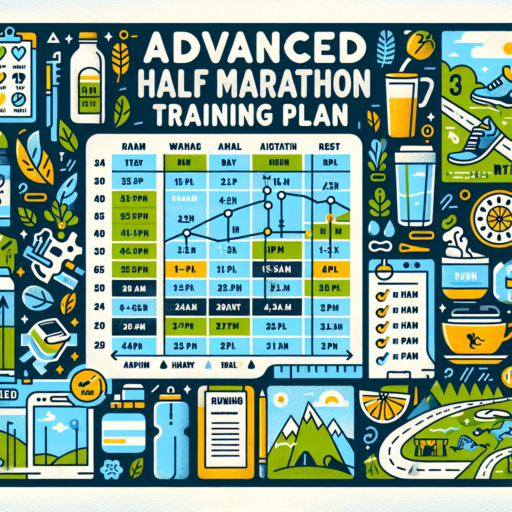1. Introduction to Half Marathon Training Plan for a 1:30 Finish
Welcome to our comprehensive guide on achieving a sub-1:30 half marathon, a goal coveted by many runners. Embarking on this journey requires not only determination but also a strategic and well-structured training plan tailored to elevate your running performance. This half marathon training plan is designed to challenge intermediate to advanced runners, aiming for that elusive 1:30 finish. Through careful planning, targeted speedwork, and adequate recovery, we’ll guide you through the key components necessary to smash your personal best.
The beauty of aiming for a 1:30 finish in a half marathon lies in the balanced blend of speed and endurance training. It necessitates a meticulous approach to building your running economy, enhancing your lactate threshold, and improving your aerobic capacity. Emphasizing on interval training, tempo runs, and long-distance runs at a pace-specific to your goal finish time, this plan integrates vital elements that prime your body to perform optimally over 21.1 km. Furthermore, integrating strength and conditioning exercises will further fortify your running form, efficiency, and resilience against injuries.
Before embarking on this training journey, it’s imperative to have a solid running base, ideally being comfortable running at least 35-40 miles per week. Adjusting your mindset for the intensity and commitment required is just as crucial as the physical preparation. This approach is not merely about logging miles; it’s about strategic progression, listening to your body, and making every run purposeful towards reaching that 1:30 finish line. Let’s dive deeper into how this training plan unfolds, presenting a week-by-week guide that demystifies the process and sets the stage for achieving your half marathon goals.
2. Essential Weekly Mileage for a 1:30 Half Marathon
Aiming for a 1:30 finish in a half marathon sets a clear, challenging goal that demands not only dedication but also a strategic training plan, especially when it comes to weekly mileage. Ideally, your training regimen should balance intensity with recovery to optimize performance without overtraining. Understanding the essential weekly mileage for achieving a 1:30 half marathon time can serve as a cornerstone for this balanced approach.
Key Mileage Range to Target
The core of your training should revolve around consistently hitting a target mileage range each week. For a 1:30 half marathon, experienced coaches often recommend a weekly mileage of approximately 30-50 miles. This range is broad to accommodate various levels of runner experience and fitness, also allowing adaptation based on an individual’s recovery and progress. It’s crucial to gradually increase your mileage to fall within this spectrum, ensuring your body adjusts without risking injury.
Incorporating Variety into Your Training
Variety in your weekly training is vital for balancing the demands of increasing mileage. Include a mix of long runs, tempo runs, and interval training, alongside easier, recovery-focused runs. Long runs are particularly important; they should make up a significant portion of your weekly mileage and are best placed on weekends when you may have more time to devote to training. This variety ensures that you’re not only building endurance but also improving your running economy and speed, crucial components for a 1:30 half marathon finish.
While focusing on hitting the right weekly mileage, listen to your body’s signals and be willing to adjust as necessary. The path to a 1:30 half marathon is unique for each runner, and personalizing your training plan according to your needs and reactions will be key to success.
3. Key Workouts to Include in Your 1:30 Half Marathon Training
To train for a half marathon with a goal time of 1:30, incorporating a mix of workouts is crucial for building the right balance of speed, endurance, and recovery. This article outlines three essential types of workouts that should be a part of your training regimen to help you reach your ambitious goal.
Interval Runs
Interval runs are a backbone of speed work that help improve your pace and increase your VO2 max, which is essential for a 1:30 half marathon. During these sessions, you’ll alternate between periods of high-intensity running and rest or light jogging. For example, after a warm-up, you might run 800 meters at a faster pace followed by 400 meters of jogging to recover, repeating this cycle 4 to 6 times. This type of workout teaches your body to handle the demands of running at a faster pace, a key component of finishing your half marathon in your target time.
Tempo Runs
Tempo runs, or threshold runs, are designed to help you increase your lactate threshold, the point at which your body starts to fatigue at a rapid pace. A typical session may involve running at a challenging but sustainable pace for 20-30 minutes after an adequate warm-up. This pace is often described as «comfortably hard» and is crucial for a 1:30 half marathon since it trains your body to sustain a faster speed without hitting the wall. Incorporating tempo runs once a week into your training can significantly improve your race day performance.
Long, Slow Distance Runs (LSD)
The cornerstone of any endurance training program, long, slow distance runs (LSD) are critical for building the stamina and mental toughness needed to complete a half marathon. For a 1:30 finish, your long runs should gradually increase until you’re comfortably running 18-20 miles at least once before your taper period. These runs should be done at a pace slower than your target race pace, focusing on time on your feet rather than speed. LSD runs not only boost your physical endurance but also prepare your mind for the mental challenge of racing.
No se han encontrado productos.
4. Nutrition and Hydration Strategies for Half Marathon Success
Preparing for a half marathon extends beyond just the physical training. Understanding the role of nutrition and hydration in your preparation can significantly influence your performance and overall experience. Fueling your body correctly before, during, and after the race is crucial. This encompasses what you eat and drink, highlighting the importance of carbohydrates, proteins, hydration levels, and even timing your meals correctly.
Pre-Race Nutrition
Before the race, your focus should be on building up your glycogen stores, as these will be your primary energy source. A diet rich in carbohydrates a few days before the event is recommended. However, it’s essential to avoid heavy meals close to the race day to prevent any digestive discomfort. Hydration should also be a priority, with a focus on steadily increasing your water intake in the week leading up to the race.
During the Race
The half marathon is a prolonged activity, and hence, maintaining energy levels is critical. Small, easily digestible snacks like gels, chews, or even bananas can be beneficial. Equally important is hydration, with a balance between water and sports drinks to replenish electrolytes lost through sweat. Planning your intake in advance, factoring in weather conditions and sweat rate, can help avoid issues such as dehydration or hyponatremia.
Post-Race Recovery
After crossing the finish line, the focus shifts to recovery. Replenishing your energy stores with a meal rich in carbohydrates and protein within two hours of finishing is ideal. This meal aids in muscle repair and recovery. Hydration continues to be important, replacing lost fluids gradually. Remember, recovery nutrition plays a critical role in your overall training cycle, preparing your body for the next challenge.
5. Integrating Speed Work into Your 1:30 Half Marathon Plan
Optimizing your half marathon performance to break the 1:30 mark involves not only increasing your mileage but also incorporating structured speed work into your training plan. Speed sessions are crucial for improving your running economy and VO2 max, both of which are essential components in achieving a faster pace over the 13.1-mile distance. Understanding the right balance between endurance runs and speed work is key to preparing your body to sustain a 6:52 per minute mile pace, which is required for a 1:30 half marathon.
The Role of Speed Work in Your Training
Speed work, often neglected by long-distance runners, includes intervals, fartlek, and tempo runs. These sessions should be strategically placed in your training schedule, ensuring they complement your long runs rather than detract from them. Intervals, consisting of short, intense efforts followed by recovery periods, improve your aerobic capacity. Fartlek, or ‘speed play,’ blends continuous running with speed variations, offering a more flexible approach to speed development. Tempo runs, performed at a challenging yet sustainable pace, enhance your lactate threshold, enabling you to maintain a faster pace for longer.
Implementing Speed Work Effectively
- Begin with a solid base: Ensure you have a good endurance foundation before introducing speed work.
- Increase intensity gradually: Start with one speed session a week, gradually adding more as your body adapts.
- Vary the workouts: Mix types of speed work to target different aspects of your running fitness.
- Recovery is key: Allow adequate recovery between speed sessions to avoid injury and overtraining.
Integrating speed work into your half marathon plan is not about running hard all the time; it’s about running smart. Tailoring the intensity and volume of these workouts to fit your current fitness level and goal pace is crucial. By incorporating a blend of intervals, fartlek, and tempo runs into your regimen, you’ll build the speed and stamina necessary to cross the 1:30 threshold with confidence.6. The Importance of Rest and Recovery in Half Marathon Preparation
Ensuring adequate rest and recovery is a cornerstone in preparing for a half marathon. Many runners focus intensely on mileage and speed workouts, often overlooking the critical role that rest days and recovery techniques play in their overall training program. Yet, integrating sufficient rest periods is paramount to allowing your body to heal micro-tears in muscle fibers, which in turn, enhances performance and reduces the risk of injury.
Rest days serve not only to physically recuperate the body but also to mentally provide a break from the rigors of continuous training. These days help in reducing the cumulative stress that running imposes on the musculoskeletal system, promoting long-term health and well-being. Furthermore, during periods of rest, the body adapts to the stresses of training, improving endurance and strength – key components to achieving a successful half marathon finish.
Recovery techniques, such as proper nutrition, hydration, and sleep, play an equally important role in a runner’s half marathon preparation. Implementing strategies like post-run stretching, utilizing foam rollers for muscle massage, and engaging in low-impact cross-training activities can significantly accelerate the recovery process. Proper attention to recovery modalities facilitates quicker return to training, enabling more consistent and effective workouts.
7. Cross-Training Activities to Enhance Your Half Marathon Training
When preparing for a half marathon, integrating cross-training activities into your regime can be a game changer. These diverse exercises not only build strength and endurance but also prevent the monotony that can sometimes accompany long-distance running routines. By focusing on a mix of activities, runners can enhance their overall performance and reduce the risk of injury. Let’s dive into seven cross-training activities that are particularly beneficial for those aiming to conquer 13.1 miles.
Swimming
Swimming stands out as a superior cross-training activity due to its low-impact nature, which offers a respite for your joints while still providing a hearty cardiovascular workout. The resistance of water enhances muscle strength across the body, including core stabilizing muscles, which are crucial for maintaining good running form.
Cycling
Cycling, another low-impact exercise, is excellent for building strength in the lower body without the stress that running imparts on your joints. Whether it’s outdoor biking or a spin class, cycling improves endurance and can simulate the sustained effort required for a half marathon, especially during uphill sections. Incorporating intervals can also mimic the varying pace of a race, making it a practical component of training.
Strength Training
Strength training is indispensable for runners. It fortifies muscles, bones, and joints, which bolsters running efficiency and diminishes the risk of injury. Focus on compound movements like squats, lunges, and deadlifts that target multiple muscle groups, replicating the complex, integrated movements involved in running. This not only improves your overall strength but also ensures a balanced development of muscles, aiding in both performance and injury prevention.
8. Tapering Before the Race: How to Do It Right for a 1:30 Finish
Preparing correctly for a race with a goal of finishing in 1:30 requires a finely tuned tapering strategy. Tapering, the process of gradually reducing training volume and intensity before a race, allows your body to rest and recover while maintaining your fitness level. However, executing it correctly is essential for achieving your targeted time without sacrificing the hard work you’ve put in during your training.
Understanding the Ideal Tapering Duration
The length of your taper can greatly impact your race performance. Ideally, for a 1:30 finish goal, a two-week taper should be sufficient. This period allows your body to heal from micro-injuries and replenish energy stores. During this phase, reduce your weekly mileage by 20-30% in the first week and an additional 20% in the second week. While it may feel counterintuitive to cut down on training, remember that the goal during tapering is to reach the start line well-rested and fully charged.
Adjusting Training Intensity
It’s not just the volume of training that should be adjusted; the intensity of your workouts is equally important during the tapering period. Maintain the intensity of your training sessions but decrease the volume. Incorporating short, sharp intervals into your taper can help keep your legs feeling fresh and your mind engaged. This method ensures that you maintain your speed without overburding your body. Focus on quality over quantity, keeping the majority of your runs easy to promote recovery.
Paying close attention to your body’s signals is crucial as you taper for a 1:30 race finish. Nutrition, hydration, and sleep become even more important during this period. A successful taper not only prepares your body for the race but also sharpens your mental readiness, setting you up for the best possible performance on race day.
9. Gear and Accessories Recommendations for Your Training and Race Day
When preparing for any race, selecting the right gear and accessories can make a significant difference in your performance and comfort. From the ground up, your choices in footwear, apparel, and even small accessories should be tailored to support your training needs and race day conditions.
Footwear: Finding Your Perfect Match
One of the most critical pieces of gear for any athlete is their shoes. A good pair of running shoes should offer both support and flexibility, tailored to your foot’s shape and your running style. It’s essential to consider the terrain you’ll be running on as well; trail runners require different support and traction than those running on roads or tracks. Look for shoes with adequate cushioning and supportive arches to prevent injury and improve your run quality.
Apparel: Comfort and Functionality
The right apparel can help regulate your body temperature, manage sweat, and even prevent chafing. Opt for materials that are moisture-wicking and quick-drying. Your race day outfit should also reflect the expected weather conditions, incorporating layers that can be easily added or removed. Accessories like compression socks or sleeves can promote circulation and reduce soreness, making them worthwhile considerations for longer races.
Essential Accessories for Efficiency and Comfort
Finally, don’t overlook the importance of properly selected accessories. A high-quality, lightweight hydration pack or belt is crucial for staying hydrated, especially during longer races or in warmer climates. Sunglasses and a comfortable hat can protect you from the sun, while a durable, easy-to-read watch can help you keep track of your pace and overall time. Small investments in these accessories can significantly enhance your training and race day experience.
10. Mental Preparation Techniques for Achieving Your Half Marathon Goals
Embarking on the journey to run a half marathon is as much a mental challenge as it is a physical one. Proper mental preparation can be the difference between crossing the finish line triumphantly or falling short of your goals. Here, we delve into essential techniques to fortify your mind ahead of race day.
Visualize Success
Visualization is a powerful tool in an athlete’s arsenal. Imagine yourself successfully completing the race, feeling strong and invigorated. Use this technique regularly, especially during training, to instill a sense of confidence and determination. This mental rehearsal not only prepares you for the physical aspect of the race but also helps in overcoming any potential mental barriers.
Set Realistic Goals
Setting achievable, realistic goals is paramount. Break your larger half marathon goal into smaller, manageable milestones. This approach keeps motivation high and allows you to celebrate small victories along the way. Remember to adjust these goals as needed to stay aligned with your training progress and physical condition.
Embrace Positive Self-talk
Turning to positive self-talk can dramatically change your racing experience. Replace any negative thoughts with affirmations and constructive self-assessment. Phrases like «I am strong,» and «I can do this,» can propel you forward during difficult times in your training or the race itself. This technique helps in building a resilient mindset that is critical for endurance sports.
Mental preparation is key to achieving your half-marathon goals. By integrating these techniques into your training regimen, you create a robust framework for success that not only applies to running but can permeate every aspect of your life.




